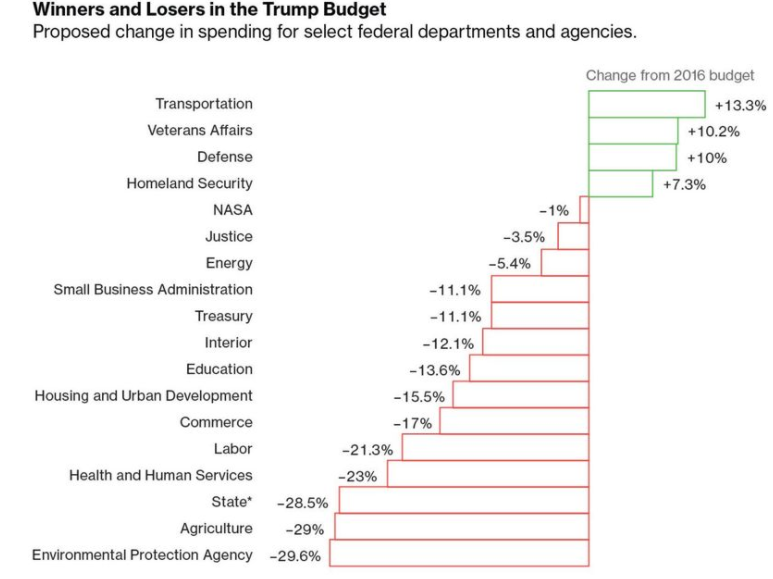President Donald Trump proposed his budget for the 2018 fiscal year which would include a $6.2 billion cut to the U.S. Department of Housing and Urban Development.
This cut represents an annual decrease of 13.2% and would allot $40.7 billion in gross discretionary funding for the agency.
This chart from Bloomberg shows the winners and losers in Trump’s budget plan, using data from the Office of Management and Budget to highlight the difference between the proposed funding in 2018 and its change from the 2016 budget.
Click to Enlarge
(Source: Office of Management and Budget, Bloomberg)
As seen in the chart, the biggest winners in Trump’s proposal are transportation, veterans affairs, defense and homeland security.
Seattle Times housing reporter Mike Rosenburg quoted the National Low Income Housing Coalition on the depth of the budget cuts.
Trump’s housing cuts would be biggest since the 1980s, when cuts “ushered in a new age of homelessness,” per @NLIHC pic.twitter.com/uGpM0QdYXI
— Mike Rosenberg (@ByRosenberg) March 16, 2017
And NLIHC President and CEO Diane Yentel expressed her disapproval of the cuts multiple times from her Twitter account.
These cuts put more than 200,000 families and seniors at immediate risk of eviction and homelessness 6/6
— Diane Yentel (@dianeyentel) March 16, 2017
A report from the Office of Management and Budget outlines the programs the administration would cut to stay within the proposed budget. Here are some of the changes in HUD programs the budget proposes:
Cuts Community Development Block Grant program – saving $3 billion
“The Federal Government has spent over $150 billion on this block grant since its inception in 1974, but the program is not well-targeted to the poorest populations and has not demonstrated results,” the report reads. “The Budget devolves community and economic development activities to the State and local level, and redirects Federal resources to other activities.”
Cuts HOME Investment Partnerships Program, Choice Neighborhoods and the Self-help Homeownership Opportunity Program – saving $1.1 billion
“State and local governments are better positioned to serve their communities based on local needs and priorities,” the report said.
Increases Lead-based paint and other hazards spending – spends $20 million more
“This also funds enforcement, education, and research activities to further support this goal, all of which contributes to lower healthcare costs and increased productivity,” according to the report.
Cuts Section 4 Capacity Building for Community Development and Affordable Housing – saving $35 million
“This program is duplicative of efforts funded by philanthropy and other more flexible private sector investments,” the report states.
The report explains HUD will continue to support homeownership through provisions of Federal Housing Administration mortgage insurance programs.
Last week, HUD Secretary Ben Carson attempted to calm fears after rumors circulated that the president was considering a $6 billion cut to HUD funding. The news was met with much resistance, however Carson emphasized that first proposals are rarely final numbers.
Now, however, the new secretary has yet to directly react to the cuts. HUD issued the following statement:
Today, the Administration proposed a Fiscal Year 2018 spending blueprint for discretionary programs in several agencies across the Federal Government, including the U.S. Department of Housing and Urban Development. The blueprint reflects the President’s commitment to support HUD’s critical functions that provide rental assistance to low-income and vulnerable households and to help work-eligible families achieve self-sufficiency. It also recognizes a greater role for State and local governments, and the private sector to address community and economic development needs. Moreover, the spending plan supports the longstanding homeownership mission of the Federal Housing Administration to provide mortgage insurance to credit qualified households. A more detailed program-by-program budget proposal will be announced in May.


